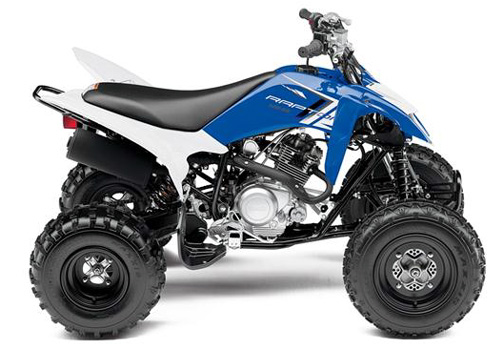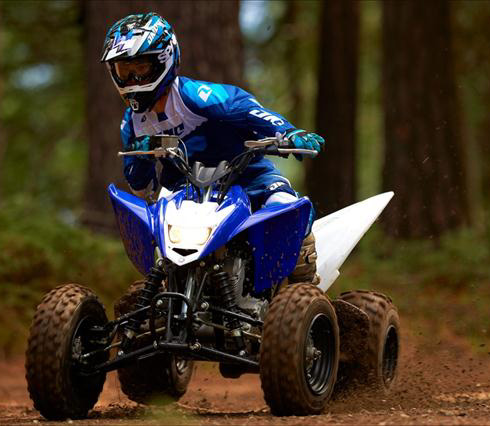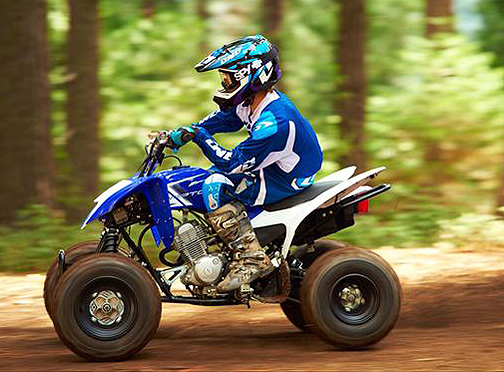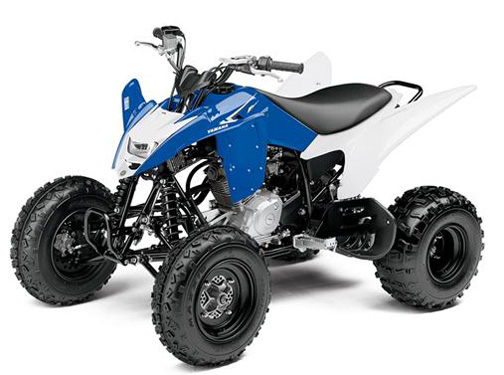ATV Test: 2013 Yamaha Raptor 125
Pint-Size Powder Keg
From afar it’s easy to classify the Yamaha Raptor 125 as an entry level ATV. After all, it’s a fairly simplistic; air cooled small bore 4-stroke nestled into a chassis that’s very user-friendly to younger, smaller and beginning riders. And if you chose to view it accordingly, we don’t fault you and neither does Yamaha. They are confident in the model’s ability to appeal to riders of all skill level.

However, like the Raptor 250 before it, the Raptor 125 speaks to the inner-child within us all; even those of us with a few extra pounds around the midsection and an unquenchable need for speed. When your ATV Connection editors received word that a Yamaha Raptor 125 would temporarily be joining our stable, we made sure to do our readers justice by testing the machine both as an entry-level ATV and a zippy play quad for the more experienced riders among us. Here’s what we discovered.
Mounting Up
In person the Yamaha Raptor 125 is anything but intimidating. Its physical dimensions are unimposing and thoughtfully composed. From a styling standpoint, the machine fits right in with Yamaha’s larger Raptor ATVs (and the omnipotent YFZ450). It’s just large enough for a younger rider to feel comfortable on with a bit of room to grow into but not so small that an adult couldn’t hop on and feel immediately comfortable in the saddle.
A brief stab of the electric starter gets the Yamaha’s air-cooled, single-overhead-cam, 2 valve 124cc engine up and running. In these days of digital tuning and high-tech fuel injection, the Yamaha flows fuel the traditional way: through a gravity-fed 29mm Mikuni carb. We found the configuration worked smooth throughout the duration of our testing, requiring a bit of choke only on the coolest fall mornings. The quad lacks any sort of backup starting system so making sure the battery is up to the task of turning over the engine is essential to avoid bump or jump starting rituals.
Once up and running the Yamaha sounds, well, mellow. Its exhaust note is smooth and quiet. There’s absolutely nothing menacing about this engine’s sounds or vibes and yanking in the clutch to put the machine in gear only further reflects this fact.
Moving Out
Yamaha wisely graced the Raptor 125 with abundant low-end power to keep beginner riders from experienced the frustrations often associated with a fully manual transmission. Feed out the clutch slowly and smoothly and the Raptor’s power kicks in to get the machine rolling. Push the thumb-throttle as far as you feel comfortable and prepare to be surprised with how wide a range that power actually spreads. The middle- reaches of each gear aren’t spectacular, instead offering up linear pull but the top end returns with a healthy surge similar to the beginning of each gear.

By the time you reach the top of 5th, prepare to be moving along at a pretty nice clip. We discovered that the larger-framed among us needed to rely upon well timed shifts and momentum more heavily to keep the quad percolating but this is to be expected considering the demographic Yamaha is targeting with this machine. Be aware that the Raptor does lack reverse to save on weight and production cost.
In the Rough
The bullet-proof transmission and adequate torque mean riders just learning the ways of the clutch will likely pick up the art of manual shifting in no time. Those of us already well acquainted with the process will undoubtedly be treating the 125 like a mini Raptor 700 by now and fortunately, there’s a lot of fun to be had in that as well! Weighing only 299 pounds (fluids included), the Raptor 125 responds remarkably well to rider input. Couple this to a peppy engine and stable chassis and you have the formula for some serious backwoods funfests.
There’s something about the smaller dimensions that make blasting around on an ATV like this feel forbidden but the terrain-feedback that gets all but muted out on a larger quad keep you coming back for more.
The suspension, though much more simplistic, is actually inspired by the larger Raptors in Yamaha’s line as well. Sporting 7.5” travel dual A-arm shocks up front (5-way preload adjustable) and a monoshock out back with 7.9” of squish, the Raptor can be skipped across whoops, pounded through roots and even land from moderate leaps without rattling fillings.

Hydraulic disc brakes all around ensure that aggressive play riding speeds can be brought back into check in a hurry with crisp modulation.
Odds and Ends
Contrary to what we suspected going into this review, the fairly low tech shocks Yamaha spec’ed for the Raptor 125 are quite capable of standing up to the abuse of off-roading, even with riders a few decades beyond Yamaha’s target audience. With an upgrade to fully adjustable units from a Raptor 250 (or the aftermarket), the machine could very easily be converted for track use. The agility and confidence-inspiring manners in this package are downright infectious. To top the spec sheet off, Yamaha includes quality low profile Maxxis tires all around- great at finding traction in just about any condition you can throw at the machine (the only exception being deep, soupy mud).
Situated at an unbeatable sub $3500 pricepoint (and that includes a Team Yamaha factory graphics kit), it’s tough to find any reason not to enthusiastically recommend this ATV to a beginner looking for peppy performance, to any wife looking for a nimble machine to take onto the trails with the hubby and for everyone else, go ahead and park one next to your 700 under the disguise of “having been bought for junior when he gets a little bigger”. Your secret’s safe with us.

More information on the Raptor 125 and all of Yamaha’s 2013 ATV line can be found at their official site.
